How Heavy Are Baby Blue Wales at Birth
Disclaimer: This post may contain affiliate links. All hosted affiliate links follow our editorial policies.
Oceans cover more than 70% of the planet, simply that doesn't fairly convey the amount of space available for aquatic animals to roam. Where land animals are express by gravity, marine animals can go from littoral shallows to trenches the depths of which humans accept barely begun to explore.
And then information technology's no surprise that the planet's largest creatures, whales, are ocean-dwelling. In terms of the globe's largest animals, the contest isn't even shut.
The next largest brute of any species, the Whale Shark , is pint-sized compared to the five largest whale species. Clearly the just manner to describe the marine mammal'due south immensity—46 feet long, 15 tons— was to proper noun it later on whales.
African Elephants , the world's largest living state animals, aren't one-10th the size of the largest whales. Even the dinosaurs weren't equally big as whales. Perhaps this explains why whale watching has become 1 of the nearly popular ecotourism activities.
If you're going to talk over whales, it makes sense to beginning with the largest whale species of them all, the Bluish Whale. Bluish Whale size and weight stats are truly spectacular, making united states humans seem tiny and utterly insignificant past comparison.
Simply in that location are enough of other fascinating Blueish Whale facts, including what they eat, where they alive, why they're endangered, how many remain, and what's being done to salve them. What follows is arguably the Internet's most comprehensive assortment of Blue Whale information.
READ MORE: Northward Atlantic Right Whale Facts
- General Bluish Whale Facts
- Blue Whale Size
- Blue Whale Habitat
- Blue Whale Diet
- Why Are Blue Whales Endangered?
- Blue Whale Conservation
- Other Blueish Whale Facts
- FAQs About Blue Whales
Full general Blue Whale Facts
1. Blue Whales are one of effectually 80 species of Cetaceans, including other whales, dolphins , and porpoises. The term is derived from an aboriginal Greek give-and-take—këtos— that means "large fish," simply all members of this classification are mammals. Cetaceans are split into two parvorders: Odontoceti, or toothed whales, and Mysticeti, or baleen whales. The Blue Whale is a baleen whale.
2. Similar other mammals, this species is warm-blooded and breathes via lungs. Mothers requite birth to alive baby Blue Whales, which they then nurse.
iii. The Blueish Whale's scientific proper noun is Balaenoptera musculus, and at that place are really three subspecies.Balaenoptera musculus musculus inhabits the N Atlantic and North Pacific. Balaenoptera musculus intermedia lives in the Southern ocean, and Balaenoptera musculus brevicauda lives in the Indian Bounding main.
iv. Despite their common name, the Blue Whale is actually a more mottled blue-grey color when out of the water. However, underwater their skin appears to be true blueish. Their pale bellies often take on a yellowish tinge, which results from the millions of microorganisms that live in their skin.
5. In addition to being the largest beast in the globe, they're amongst the longest living animals as well. The average Blue Whale lifespan is 80 to ninety years, merely some live to 110 ( Bowhead whales are the longest living mammal, at over 200 years). Strangely, a whale's historic period is calculated past counting the layers of their waxy earplugs, á la tree rings!
READ MORE: Southern Resident Killer Whale Facts
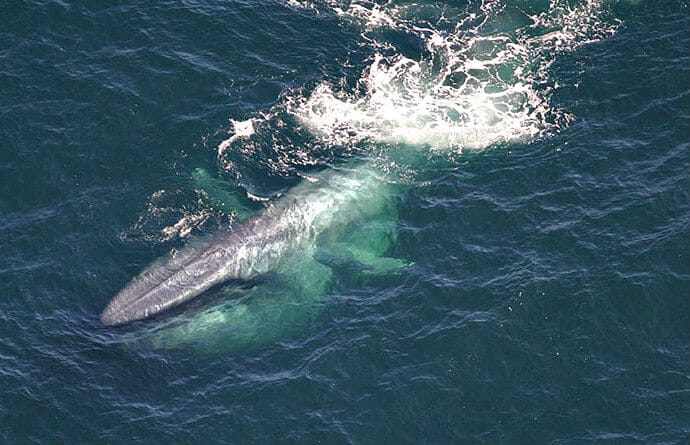
Blue Whale Size
6. Bluish Whale size is staggering to consider: They tin measure in the vicinity of 100 feet long (making them the longest beast in the globe), and can weigh up to 200 tons. It's difficult to conceive when we imagine something then big that sometimes moves at considerable speeds.
7. The Blue Whale is the largest animal ever known to have lived on Earth. They are larger, longer, and heavier than any other animal, including all known species of dinosaurs.
8. More trivial tidbits nigh Blueish Whale size: Its tongue weighs every bit much as an elephant and is roughly the same length. The Blue Whale weighs the equivalent of about 40 full-grown elephants , with a heart as heavy as a Volkswagen Protrude. It's nearly as long as 2.5 school buses , measured bumper-to-bumper.
9. Blue Whale weight has been difficult to calculate due to the animal's sheer mass. In lodge to weigh them, deceased whales have to be cut into manageable pieces (for scales that weigh trucks) and the sum total calculated. This results in fluid and blood loss that also has to be accounted for.
ten. Baby Blue Whales enter the earth already ranking amongst the largest animals, averaging iii tons and 25 feet. They gain about 200 pounds every day for their start twelvemonth of life, feeding on nothing but mother'due south milk for the first few months.
xi. The big Blue Whale also has the largest os (its mandible), brain, and penis (more info on that below) of any beast on the planet.
12. Female Blue Whales are actually larger than the males.
13. Despite the Blue Whale's size, it actually has a slender overall advent compared to another species of whales. From its wide head, its elongated body tapers into something that could easily be described as svelte.
xiv. At its widest point the Bluish Whale measures most 25 feet beyond, accounting for the largest flukes (a.thousand.a. tail fins) of all.
fifteen. As is the case with many baleen whales, Blue Whales accept small dorsal fins (the top-of-body ones that sharks are famous for). A Blue Whale'southward dorsal fin only measures an average of almost 11 inches long. A male Orca'due south dorsal fin, on the other hand, tin can abound up to six feet tall!
READ MORE:60 Weird Animals Around the Globe
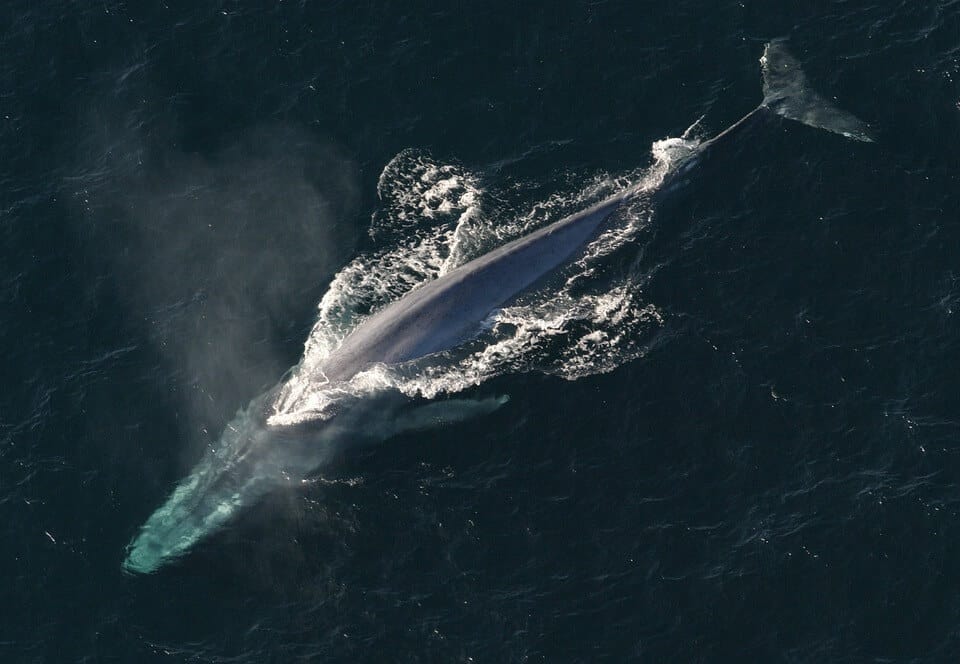
Blue Whale Habitat
16. Given their gargantuan size, you may be wondering where does the Blue Whale live. Interestingly, the answer is merely almost everywhere! Blue Whale habitat encompasses all of the planet'due south oceans, though not necessarily at all times of the year.
17. Blueish Whales mostly like to spend their summers in absurd polar waters . This is their feeding season, and their favorite food becomes more plentiful when colder environs warm up. The biggest Blue Whales are known to reside near Antarctica.
xviii. During the winter, Bluish Whale migration patterns move them towards the equator. Only they tend to avoid seas that are likewise warm, because they tin can easily overheat. This migration to warmer waters also helps with their reproduction cycle.
nineteen. Blue Whale reproduction includes a 10- to 12-calendar month gestation period. Mothers give birth every two to iii years, often in the same habitat in which they were impregnated.
20. Blue Whale migration tin occur in small groups (called pods), but they're ordinarily content to travel solo or in pairs. Even when they seem to be traveling lone, scientists who study Blue Whale beliefs advise they're actually moving in pods miles apart, communicating via calls underwater.
21. Blue Whales usually swim at virtually five to 12 miles per hour. Only when threatened (or inspired past other agile whales), these behemoths can use those massive flukes to move at up to 30 miles per hour.
22. The nearly concentrated Blueish Whale habitats in winter are the waters off of Baja California, Mexico and Pico Island, Portugal . During the summer, they frequent Quebec'due south Gulf of St. Lawrence and Husavik, Iceland . Chile, the Republic of the maldives, and Sri Lanka are also prime spots for Blue Whale watching.
23. If yous're out looking for Bluish Whales, proceed in mind that they prefer to live in deep oceans and are rarely seen close to the shore. Weighing in at over 100,000 tons, how would they get there? These big, blue behemoths really demand the space of the open seas.
READ More than: Whales That Live in Antarctica
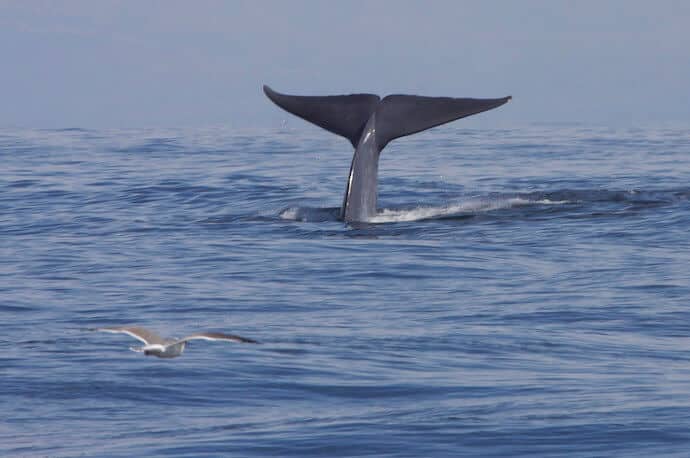
Bluish Whale Diet
24. Though Blue Whales are known as gentle giants, they're actually carnivores and apex predators. Simply put, they feed on other animals, and generally travel the oceans without worry of predators attacking them. This makes them vital to well-functioning marine ecosystems.
25. Like all baleen whales, Blue Whales don't accept whatever teeth. Instead, they have a system of fringed plates made of keratin (fingernail-like material) that filter out prey rather than tearing it apart. To feed, they take enormous gulps of h2o, then force the h2o out through the plates. This process ensnares minor marine animals, which they so consume whole.
26. The Blue Whale diet is more often than not made up of Krill– shrimp-similar creatures that are very small (almost the two inches long). Nevertheless, using this gulp-and-filter technique, Blue Whales are known to swallow 4 tons (approximately xl million krill) a twenty-four hour period during peak feeding flavor.
27. During migration (which can final up to 4 months), Blue Whales eat very picayune, instead living off the blubber they've acquired during peak feeding season. Despite their massive size, they only have a thin layer of blubber when compared to other whales. For example, Right Whales–which weigh a mere 100 tons and grow about threescore feet long– are much more than blubbery.
28. As mentioned in a higher place, baby Blue Whales can gain over 200 pounds a day, averaging out to nearly ten pounds an hr. This is accomplished by drinking up to 100 gallons of their female parent's milk (which is 35-50% fat) each 24-hour interval. They're weaned at near 6 months, by which time they're already over 50 feet long. After weaning, young whales start consuming solid foods and hunting their ain prey.
READ More than: Protecting Whales & Dolphins in Golfo Dulce, Costa Rica
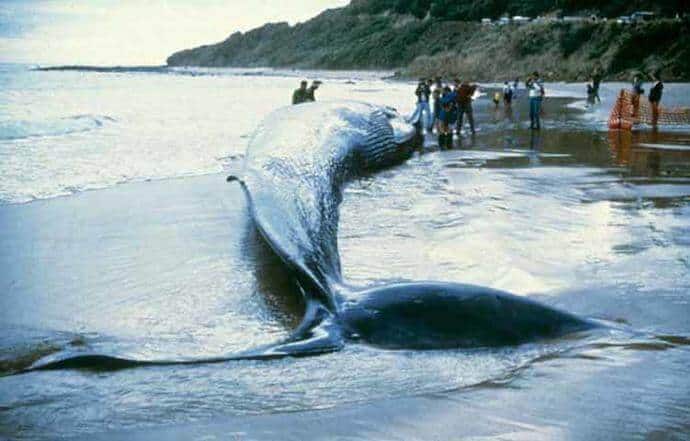
Why Are Blue Whales Endangered?
29. Given their massive size, you might wonder why Blue Whales are endangered according to the IUCN Red List. The only known Blue Whale predators (which are rarely successful) are pods of hungry Orca. And even these "Killer Whales" rarely prey on anything larger than a infant Blue Whale.
30. Prior to the 20th century, Blue Whale numbers were estimated in the hundreds of thousands. Approximately 95 to 99% of their global population was decimated by unchecked whale hunting . Their total number is currently estimated to be around 10,000, and slowly growing.
31. Commercial whaling was banned in 1986 past the International Whaling Commission. But some countries have objected to the ban on cultural grounds, including Iceland and Norway currently likewise as Russia and Japan historically. At least 2.8 million whales were killed in the 20th century alone.
32. Nowadays, with the oceans steadily warming, climate change is becoming a serious Blue Whale threat. The warm waters are increasingly shrinking the Blue Whale's habitat and distorting their annual migration patterns. The effect of climate change on Krill is fifty-fifty more problematic, as they need tons of Krill each day in gild to take successful breeding cycles.
33. Other issues threatening Blue Whales include ship strikes and becoming ensnared in fishing nets. Lots of shipping routes cantankerous their migratory routes, and irresponsible fishing practices from modern-24-hour interval vessels and fishermen in the by have created problems by discarding their nets in the ocean.
READ MORE: 15 Harmful Traditions & Cultural Practices Tourists Should Avoid
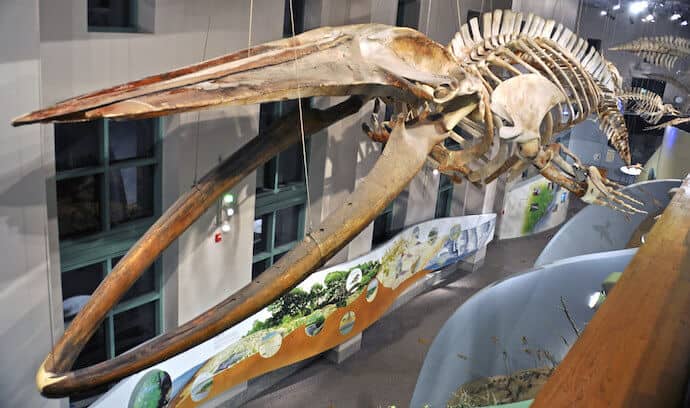
Blue Whale Conservation
34. Bluish Whale conservation efforts have been both numerous and largely successful. Almost of them take centered around stopping whaling in general, with only a scattering of countries remaining among the holdouts. Luckily, Blue Whales are non among the list of cetaceans almost probable to exist hunted.
35. The International Whale Commission created whaling regulations in 1946 and enacted an all-out ban in 1986, referred to as the commercial whaling moratorium. Blue Whale protection has also been extended under the Species at Risk Human activity (Canada) and Endangered Species Act (United States), among other initiatives beyond the globe.
36. Blue Whale protection also comes from a bevy of other wildlife conservation organizations , such every bit Whale and Dolphin Conservation, Save the Whales, and Sea Shepherd Conservation Lodge. These NGOs make efforts to prevent whaling, safeguard Bluish Whale habitats, reconfigure problematic aircraft routes, and keep the body of water clean.
READ More: Jean-Michel Cousteau on the Future of Marine Conservation
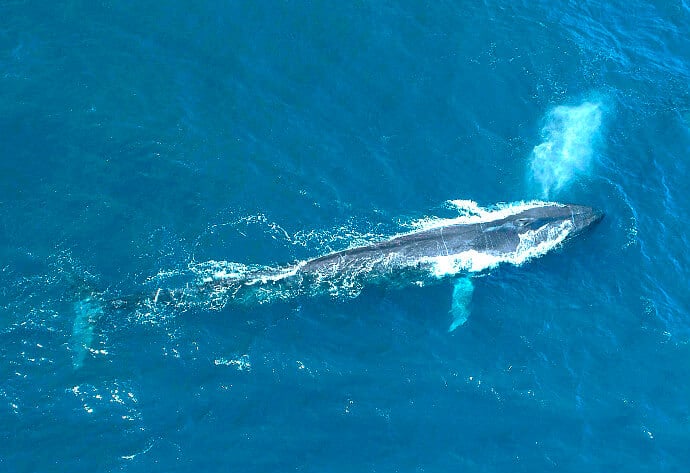
Other Blue Whale Facts
37. Blue Whales are one of the loudest animals in the world. They emit pulses, groans, and moans that tin be heard hundreds of miles away. These songs can exist used to communicate, navigate, and for mating purposes. At 188 decibels, some of their calls are louder than a jet engine. But, at 15-40 Hz, they are frequently below our human hearing range.
38. Every bit mammals, Blue Whales require lungs and air to breathe. They inhale and exhale via their blowhole, which is located on acme of their massive heads. For deep dives, they can take in enough oxygen to last xc minutes underwater, simply typical dives only last half an 60 minutes. When they breathe, the spray that erupts into the air is from water that congregates atop the blowhole while submerged.
39. The Blue Whale's mouth is extraordinary! Their throats take expandable pleats, and their mouths can open so wide that some other whale could actually swim into them. Scientists studying this miracle calculated that the Blue Whale's rima oris captured enough food during a truncated 11-minute dive to provide 100 times the energy used to make the dive in the first place.
40. At the take chances of being grotesque, the Blue Whale'due south penis is dumbfounding, reaching 8 to 10 feet long. It weighs several hundred pounds, but is subconscious inside a genital slit during normal daily activities. Each time they have intercourse, a Blue Whale can ejaculate 30-40 pints of semen, which increases their chances of reproduction and flushes out the sperm of competing males.
READ MORE: Blackfish Director Gabriela Cowperhwaite Takes on Ocean World
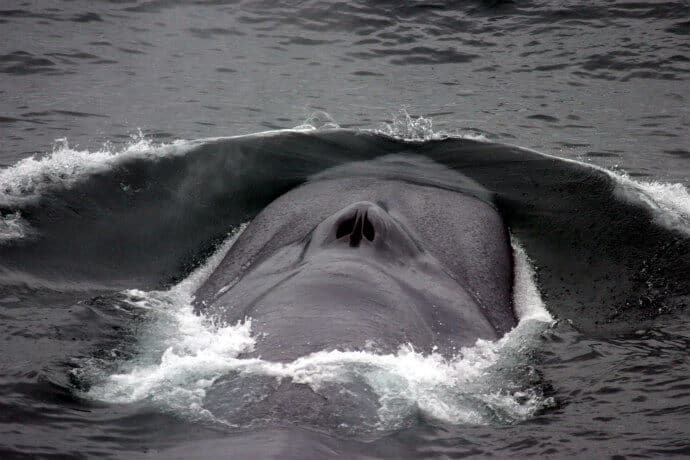
FAQs Near Blue Whales
How many Blue Whales are left in the earth?
The numbers are somewhat up for argue, but most NGOs seem to settle somewhere close to 10,000. Pessimistic groups might gauge a population somewhere in the five,000 to 10,000 range, whereas more optimistic collectives might stretch their Blue Whale numbers upwards to 25,000.
Despite beingness by far the largest animals on earth, Blue Whales are notoriously elusive. So it'south very hard to get an accurate read on theit global population.
That beingness said, what we exercise know for sure is that over 350,000 Bluish Whales were killed by hunters betwixt 1900 and 1960, prior to the International Whaling Commission putting regulations on the practice. Since and so, these gentle giants have rarely died by the harpoon.
What practise Blue Whales consume?
For the most part, Bluish Whales eat Krill. Krill are tiny crustaceans that resemble shrimp and are virtually the size of a human's pinky finger.
During feeding season, they can swallow about 4 tons of Krill a twenty-four hours. They do as well consume other sea creatures, including a few other crustaceans, as bycatch to the Krill.
What is the departure between a male and female Blue Whale?
Female person Blueish Whales are actually the larger of the species, averaging about 32 feet (or 10 meters) longer than males and weighing around thirty,000 tons more.
Obviously, they accept different sexual organs, but they are otherwise very like in color, appearance, habitat, and migration.
Female Blue Whales are called cows, while males are called bulls. Infant Blue Whales are called calves.
Are Bluish Whales the biggest creature ever?
Blue Whales are the biggest animal currently in beingness, including beingness the longest, largest, and heaviest. They are also the largest known animal to have ever existed. The Finback Whale is nearly as long every bit its Blue cousin, measuring close to 90 feet long. But it weighs significantly less.
The Correct Whale, the planet'southward 2nd heaviest fauna, tin go up to 100 tons, which is well-nigh half what the largest Blue Whale can weigh. The largest African Elephant– the world'southward biggest living land animal– is most a quarter the length of a Blueish Whale, and just one-fortieth the weight.
Due to space and buoyancy, ocean-going animals like whales can grow to exist much larger than land animals, which need skeletons that can support their bodies.
Are Bluish Whales bigger than dinosaurs?
Blue Whales are bigger than dinosaurs, particularly those puny T-Rexes and other noon carnivores. A few members of the sauropods– herbivorous dinosaurs with long necks– are projected to accept possibly been longer than Blue Whales.
Supersaurus and Argentinoasaurus are believed to have been over 100 feet long. However, their dimension projections are based on only a few basic, with nothing fifty-fifty shut to an entire skeleton.
Nearly half of their length was in their necks, then Blueish Whales are believed to easily counterbalance twice as much (or more than) as these dinosaurs did. In other words, non only are Blue Whales bigger, but they are MUCH larger than even the biggest, fabulous dinosaur. —Jonathon Engels
How Heavy Are Baby Blue Wales at Birth
Source: https://greenglobaltravel.com/blue-whale-facts/
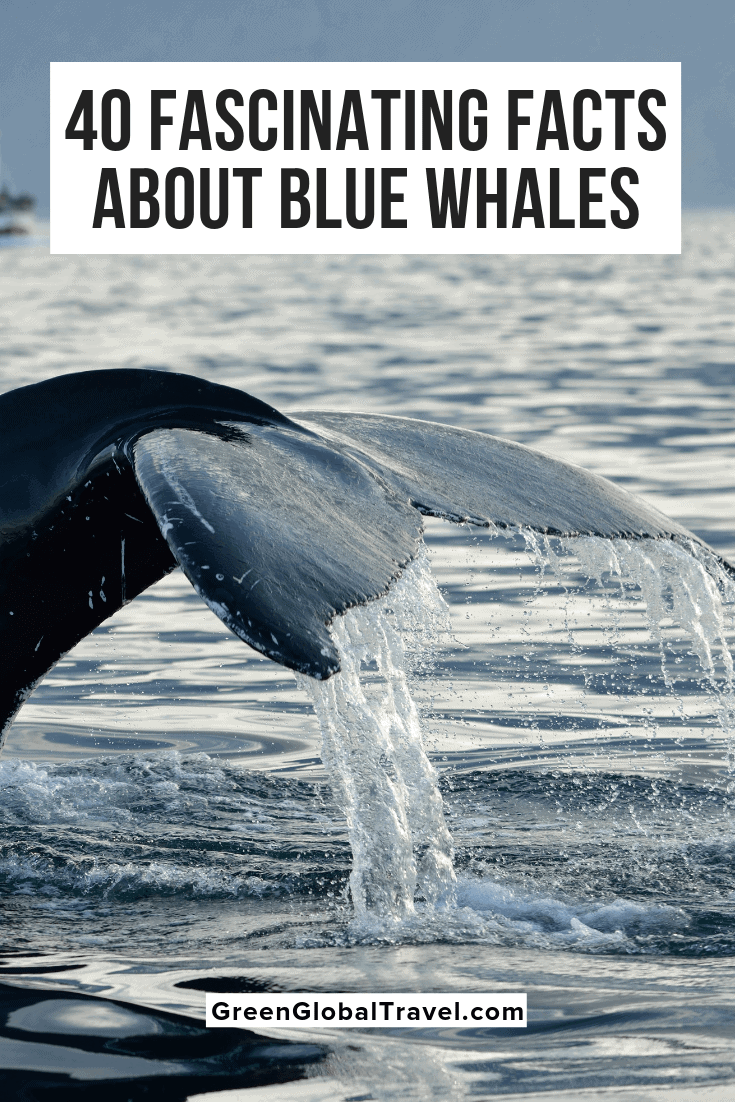
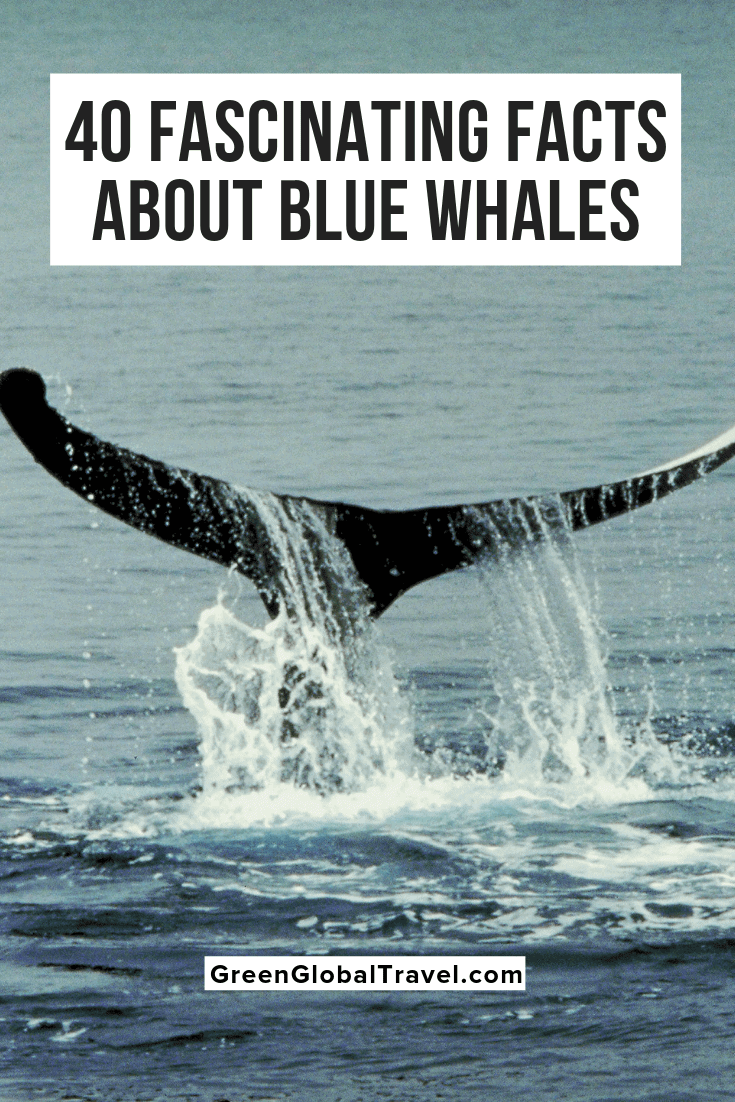
Post a Comment for "How Heavy Are Baby Blue Wales at Birth"